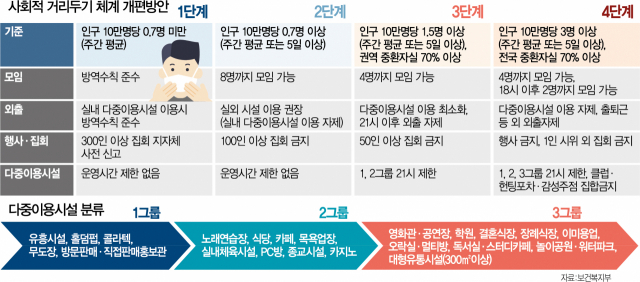Prohibition of meetings with more than 9 people in the 2nd stage and 5 people in the 3rd stage
In stage 4, it is limited to 2 people after 18:00
Restaurants, cafes, etc. are not limited to the second level.
Expanding the scope of business for self-employed and small business owners
Cadastral map of “Additional reflection of vaccine vaccination rate, etc.”
 viewer
viewer
The draft plan for the reform of the third social distancing system, prepared by the government, focused on regulating individual activities as the number of confirmed cases of the novel coronavirus infection (Corona 19) increases.
Unlike the first and second reorganizations, it is based on the judgment that the spread of Corona 19 has changed not through collective infection by specific places or groups, but through personal contact. Accordingly, the existing distancing system, which focused on restricting the operation of certain facilities, was moved to the regulation of individual activities. In addition, it is analyzed that they are conscious of the controversy over the existing distance positioning system.
The draft of the new distance reorganization first simplified the existing 5 steps to 4 steps. The existing five-stage distancing was a strategy to implement detailed measures by subdividing the steps, but the steps were made up of 1.5 steps, 2 steps, etc., so it was not enough to give alertness to the raising of the distance. Since most of the measures are focused on the business of multi-use facilities, it is also true that the quarantine management of individuals who actually spread the virus was neglected. In particular, in the third outbreak that has continued since November of last year, most of the confirmed cases occurred at small meetings through family and acquaintances, increasing the need to strengthen individual quarantine rules.
First of all, reflecting the opinion that the gap in the number of confirmed cases between the metropolitan area and the provinces is large, the standard for determining the distance is changed to a standard per 100,000 population rather than a simple number of confirmed cases. The average number of new confirmed cases per day for a week is 0.7 per 100,000 people (363 nationwide) in the first stage, and those with more than 0.7 in the second stage. If there are more than 1.5 (778 people nationwide) and the regional intensive care unit saturation is more than 70%, the third stage, when there are more than 3 people (1,556 people nationwide) and the national intensive care unit is more than 70%, the fourth stage is applied. For the last week, the average number of confirmed cases per day is 389.3 (0.75 per 100,000 population), and the second step is applied by applying the reorganized distance.
Prohibition of private gatherings is also implemented by differentiating the distance between them. There is no limit on the number of meetings in the first stage, and meetings with more than 9 people in the 2nd stage, 5 or more in the 3rd stage, and 5 or more in the 4th stage are prohibited. Events such as weddings and funerals are also limited to 100 and 50 people in the 2nd and 3rd stages, respectively, but only immediate family members can participate in the 4th stage. In particular, in step 4, a ban on meetings of three or more people is applied from 6 pm onwards, and measures equivalent to the ban on going out are taken.
Various facilities, which have been controversial about equity, are divided into three groups and managed according to the risk of infection. Individuals have increased their sense of responsibility for quarantine practices, and the business scope of self-employed and small business owners has been expanded. Group 1 includes entertainment facilities such as Collate and Hold’em Pub, Group 2 includes singing practice, indoor sports facilities, cafes and restaurants, and Group 3 includes movie theaters, performance halls, wedding halls, funeral halls, Lee Beauty, and reading rooms. There is no operating time limit across all facilities in the first step of the distance. However, from the second stage, the number of users is limited to 30% or 50% of 1 person/seat per 8㎡ of area. Moving on to step 3, the operating hours of the 1st and 2nd group workplaces will be limited to 9pm. In the fourth stage, all groups 1 to 3 are closed after 9 pm, and clubs, hunting pots, and sensational pubs are banned from collectively. Sohn Young-rae, head of the Social Strategy Division, Central Accident Control Headquarters, explained, “Emphasis is placed on autonomy and responsibility for multi-use facilities, and the ban on collectives, which is a de facto business ban, will mostly disappear.”
However, the quarantine authorities are also considering a plan to limit the business hours to 11 pm for three types of businesses: entertainment facilities, singing practice centers, and restaurants and cafes during the second phase. In the second stage, it is possible to meet up to 8 people, but it is pointed out that only the limit of the number of people used per 8㎡ may lead to a lack of awareness. There is also an opinion that indicators that will be reflected in the step adjustment, such as test positive rate and vaccination rate, should be added. Kim Moran, a professor at the National Cancer Center, who attended the public hearing said, “At the first stage, there are some contents that I would like to discuss and review again, such as areas where there is no limit on the size of private meetings. In order to do so, it is necessary to consider ways to increase the efficiency by considering and applying a more convenient self-test method,” he said. The government plans to decide the final draft of the distancing reorganization within this month by combining the contents of the draft and discussions at the public hearing.
/ Reporter Ji-hye Seo [email protected]
< 저작권자 ⓒ 서울경제, 무단 전재 및 재배포 금지 >
